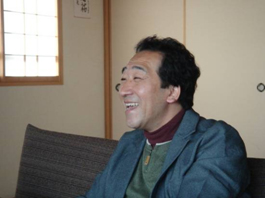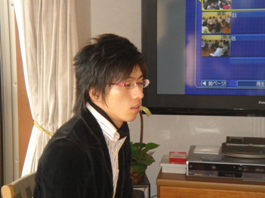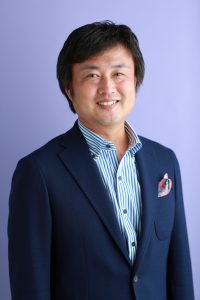

The Simplest Lesson by A Great Japanese Teacher, Mr. Tetsuya Tsuji Vol.2
How to interact with students from a comparative standpoint
Basically, teachers and students do not stand equal, I believe. However, teachers should interact with students from a comparative standpoint.
For example, if some student is looking aside in class, I warn him to look straight.(laughing)
 If it happens at the begging of the school year, I won’t scold him. Instead, I will ask him why he was looking aside. Is he having trouble understanding the content? Or does he dislike my way of speaking? Or does he just hate me? I won’t know the reason until I actually ask him. You need to put yourself into other people’s shoes if you are to ask. Things start from here.
If it happens at the begging of the school year, I won’t scold him. Instead, I will ask him why he was looking aside. Is he having trouble understanding the content? Or does he dislike my way of speaking? Or does he just hate me? I won’t know the reason until I actually ask him. You need to put yourself into other people’s shoes if you are to ask. Things start from here.
One girl was afraid of me at the beginning because she had never experienced male teachers. I didn’t force her to change her attitude. Rather, I told her, “You feel scared of me and you cannot help it, right? It’s fine. Because I am here as teacher, I teach as I usually do. But you don’t have to force yourself to accept it.” Gradually she got used to me.
I won’t force students to open their hearts. I think it the same as “approval” in coaching. You can’t force someone to like something.
The other way is to share the same story. I always give students handouts for each topic, for textbooks are not enough. They are not made from students’ point of view. I change questions in textbooks into the ones familiar to students.
For example, here is a question, “Mr. Inagaki bought 10 apples. Each was 50 yen. How much did he pay?” Then I change it like this, “Tetsuya bought 10 apples at Kondo’s market.” Tetsuya is an actual student in class, and everybody also knows about the local store Kondo’s market. Only such small modifications can attract students’ attention.
Students are unique every year. So I cannot use the same handouts as the previous year. Though I use the same handouts at the beginning, I eventually make new ones as I get to know about them.
You can see most clearly in Japanese class how different students are. Students react very differently. Students’ competence greatly differs from one year to another. But you shouldn’t lower the target level based on their capability. You shouldn’t underestimate students’ abilities. What you need to do is to change approaches toward the goal.
For that purpose, we form classes according to the degree of achievement.
In math class, for instance, we adopt the grouping system but the goal for every student is to score 100 percent.
If you are to teach the multiplication table, some can learn quickly while others cannot. Then, for those struggling, you use tools like cards or computer applications so that they can achieve the same goal as the others.
Another example is science class. Suppose you are going to explain air current: warmer air goes up while cooler air goes down.
With competent students, you just need to ask a simple question, “Why do you think it happens?” They will start heaping up desks and wandering about to find a thermometer to measure the temperatures.
However, with less competent students, you have to ask more detailed questions, leading them to speculate what methods they can use. In time, they come up with ideas saying, “Can we measure with a thermometer?” “OK. I will go to get it and you discuss how you do it in group”, I reply. Then they start thinking in group. In order to conduct a class this way, you need to be prepared. The most effective is to use your own handouts to assist students to think for themselves using coaching flow. It is not anything complicated. You just need to learn some skills.
How to respond to students
If you are an experienced teacher and spend a certain amount of time with students, you can predict how they will respond to your questions.
But the point is whether you can make the most of their responses.
How many possible replies can you think of to their expected remarks? This is the key.
For novice teachers, it is very difficult. They can follow the manual but can hardly play beyond it.
My senior once told me, “You should prepare as many questions as possible that would interest students. Ask questions using your own handouts.” He made me aware that asking questions is crucial.
When I was a new teacher, I used to be told to prepare several replies for each student’s response. In training, I was told to think of more than 60 different replies to each response from students. Of course, it helped me a lot. But it was much more effective to be trained in class. Students are your best teachers.
If you are doing well in class, you will have more responses from students. Then you have more chances to reply. In fact, it is easier if you give a poorer lesson. Students will listen to you quietly and won’t challenge you. On the contrary, if you give a good lesson, students will actively respond, and then you have to reply. You are always forced to think how to respond, and eventually you will be thoroughly trained. You should face students in real earnest. I often tell students, “We play for keeps in class.”
Reconcile a goal with school hours
In math class, for example, I let students think how it can be so. First, I fix the time to think. Then I ask questions. I spare 10 minutes to let students think it over, and I give chances to speak out to those who didn’t make it out. By doing so, I bring out what they didn’t understand. A student will say, “I see this, but I don’t get anything beyond it”, and then I ask the whole class who can settle his question. Some students just want to stand out and keep talking, but if you raise this kind of questions, you can pick appropriate students.
 Still there is a problem. Usually time runs out because it takes time if students explain in turn trying to make everyone understand. In primary school, you can extend the time because you teach all subjects in your classroom. However, I think a class has to be done in time. This is my idea, but students don’t care about time. It puzzled me.
Still there is a problem. Usually time runs out because it takes time if students explain in turn trying to make everyone understand. In primary school, you can extend the time because you teach all subjects in your classroom. However, I think a class has to be done in time. This is my idea, but students don’t care about time. It puzzled me.
Then I came to the conclusion that I have to divide the time clearly: one for students to think for themselves and the other for a teacher to explain.
I think a class should be finished in 45 minutes basically. In my handouts, there is blank space for students to writes down their own ideas. I need to make clear how much time I should spend in their self-work and in their explanation to others respectively. I think it’s important to priotize whether you want students to think for themselves, be active in class, be trained or gain knowledge.
How to use coaching skills in school
I hadn’t realized I had been using some coaching skills until I took a coaching training seminar.
Now I believe coaching is helpful in teaching students communication skills, especially today because students are said to lack in them. Junior high schools are becoming too loose. It gets worse in the final semester. We have to take measures against it.
I don’t think counseling is very effective. What students need is to look forward to make progress, not to look back on the past. Students have to be supported so that they can stand on their own feet. I believe coaching can do it.
In books on coaching, they say a coach should believe, affirm, and entrust. It’s exactly what we do by writing class papers.
First, we believe students are capable and their parents accept them too. Then we let students try and affirm them. Instruct, explain, let them try and approve. I understood the importance clearly from the books.
It was very interesting to read the book “If I were a rabbit coach…” It puts extremely simply what education books say. Coaching claims the same as education books do. I think coaching should be useful in school education.
Coaching can also be a great tool to train up young teachers to key players.
In junior high school, teachers are in charge of a certain subject. They take different trainings according to their specialty. But as for moral education and teaching methods, every teacher can participate in the same training, and coaching best works as a tool in the trainings. Whether you teach in junior high school or primary school, or even preschool, coaching is fundamental. Coaching can be arranged to each school. The principle is to respect students, listen to them, let them share their ideas, and think together. You can also set a goal with coaching.
Did you enjoy reading his interview? In fact, Mr. Tsuji has taken more approaches than introduced here. He has succeeded in most cases. Now he is going to tell how it worked.
When teachers aren’t shining, how can students be?
When teachers are shining, students are also shining.
How come students can be shining when teachers aren’t?
How come students can be shining when the teachers’ room is dull?
It’s similar to a difference between a Buddhist statue and earth teapot.
Both are made up of the same materials but are completely different.
A Buddhist statue is shining while a teapot is sooty over a stove.
A statue is shining because someone polishes it everyday while no one polishes a teapot.
It is true for us. We start shining when we are with someone who is willing to polish us.
We should polish each other. If the teachers’ room is the place for teachers to educate each other, they will start shining. The same materials can become either a Buddhist statue or teapot. This parable is of a Zen priest Kosan, a teacher of the great general Masamune Date.
Teachers help children shine
So what do teachers do? I think we help children shine, though it may sound cockily.
Teachers and coaches are similar in role. Some people say a teacher’s role is just to provide knowledge, but I disagree. Teachers also have to teach students how to learn, how to develop and how to teach.
If you teach students only knowledge, they will always need your help and won’t be able to succeed without you. If you teach students how to learn, they will do fine even after they graduate because they know how to settle problems. This is what coaching is all about, isn’t it?
If students have gained enough skills and have successful experiences, they won’t be egocentric; rather they will influence other students to get inspired. They have successful experiences such as “I agreed with him” “I listened to her carefully” “I first listened to them before I spoke out” “I spoke words of cheer to her.” They apply those experiences to other situations and it spreads out serially.
Those students without successful experiences won’t be able to utilize their ability fully even if they have skills. Successful experiences are essential to handle their own skills.
We need to educate students to the extent that students can gain both successful experiences and skills before they graduate.
Schools have a great power to nurture children, which I think we should respect most.
The importance of school resources
I don’t think it a good idea to have a charismatic teacher in school.
I think all teachers in school should work together for the better.
I was lucky that I always had great seniors and colleagues around. I am thankful to principals and my seniors who made me aware of school resources. I am also thankful to my colleagues who spent time with me till late at night and shared joy, anger and sorrow.
With such human relations, a school builds up its strength.
I am in the position to develop school resources now, and have truly realized how difficult it is and how long it takes.
TV dramas are still featuring a charismatic teacher as 10 or 15 years ago. Here is a typical scenario: the teacher is not affirmed by anyone except for one enthusiastic student at first, but he or she gradually gets support and finally succeed in a drastic school reform.
They also features schools and students of other days. They describe problematic students as those with extremely strong personality or too much energy to control, but in reality, students today are suffering from different types of problem: mental problems, family problems or financial problems. These cannot be solved only through classroom management or mutual trust with each student. Of course, every teacher is making a great effort to deal with a variety of problems but it is only in a few lucky schools that a teacher can handle problems in class for himself. School recourses are becoming increasing important.
Coaching can greatly help us share our thoughts and connect us. I expect it can also boost school recourses.
Editorial note
I met with Mr. Tsuji when I started working as a new teacher.
I my first year, I didn’t know anything about teaching and my seniors gave me knowledge and skills. Bur Mr. Tsuji was a little different. He asked me questions instead.
“What do you think about this?”
“How do you think you can achieve it?”
“Would you like to try this?”
I was nervous at first when I was asked a question.
However, Mr. Suzuki always carefully listened to me without interrupting till the end, sometimes in agreement or in surprise. When I finished answering, I found myself urging to take action. It also helped me to find out my own educational philosophy.
When I was feeling down or distressed, he was watching over me from afar and gave me a few words to cheer me up. He sometimes asked my colleague to take me out for a drink by giving his pocket money. He is a really loving person.
Moreover, he taught me that affection is not enough as teacher. Teachers should be skillful. No matter how deeply you love your students, you cannot develop their academic skills to a certain level in a fast-paced school life if you don’t have concrete skills as teacher. I learned from him to interact with students with strategies.
In the meantime, I came across with coaching.
I was convinced coaching is the very tool that can help me interact with students skillfully and strategically as Mr. Tsuji mentioned.
As I interviewed successful teachers, I found they often show coaching skills or coaching minds with students.
Schoolteachers have surprisingly great skills that have been passed down for a long time. Those are powerful and valid in today’s society where exist diverse values.
Unfortunately, it is not widely known to people how skillful schoolteachers are.
I hope this interview article helps to understand the high skills schoolteachers hold.
I confirmed coaching is not a new technique but is a system made up of existing wisdom.
I am fortunate enough to have experienced the teaching profession being surrounded by naturally skillful teachers. I am very thankful to the people and environment that educated me.
Interviewer
Tomohito ‘Johnny’ Inagaki

After graduating from School of Teacher Education, Kanazawa University, he taught both in primary schools and junior high schools in Mie Prefecture. Then he transferred to the Board of Education of Mie Prefecture. After 14 years of his career as teacher, he became the first professional coach with teaching experiences in public schools in Japan. He started using coaching skills in 1997, right after coaching was first introduced into Japan. By using coaching skills, he has consulted more than 500 children and parents and helped them develop their gift. He miraculously changes every person’s weaknesses to strengths. He is one of the best professional coaches in the field of education in Japan.
Currently, he is actively working for the board of education, governmental agency and schools as advisor on coaching. He carries out more than 100 lectures and projects a year and he has taught coaching to more than 10,000 educators and students.
He acted as a succor coach for representative players under 14 years old in Mie prefecture.
He holds the Professional Certified Coach (PCC).
From 2007 to 2008, “Educational Coaching Promotion Advisor” at the board of education of Mie prefecture
“Co-creative Coaching Advisor” at Graduate School of Engineering, Utsunomiya University

